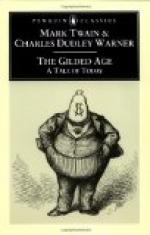Presently they were ranged about an old-time fire-place whose blazing logs sent out rather an unnecessary amount of heat, but that was no matter-supper was needed, and to have it, it had to be cooked. This apartment was the family bedroom, parlor, library and kitchen, all in one. The matronly little wife of the Colonel moved hither and thither and in and out with her pots and pans in her hands’, happiness in her heart and a world of admiration of her husband in her eyes. And when at last she had spread the cloth and loaded it with hot corn bread, fried chickens, bacon, buttermilk, coffee, and all manner of country luxuries, Col. Sellers modified his harangue and for a moment throttled it down to the orthodox pitch for a blessing, and then instantly burst forth again as from a parenthesis and clattered on with might and main till every stomach in the party was laden with all it could carry. And when the new-comers ascended the ladder to their comfortable feather beds on the second floor—to wit the garret—Mrs. Hawkins was obliged to say:
“Hang the fellow, I do believe he has gone wilder than ever, but still a body can’t help liking him if they would—and what is more, they don’t ever want to try when they see his eyes and hear him talk.”
Within a week or two the Hawkinses were comfortably domiciled in a new log house, and were beginning to feel at home. The children were put to school; at least it was what passed for a school in those days: a place where tender young humanity devoted itself for eight or ten hours a day to learning incomprehensible rubbish by heart out of books and reciting it by rote, like parrots; so that a finished education consisted simply of a permanent headache and the ability to read without stopping to spell the words or take breath. Hawkins bought out the village store for a song and proceeded to reap the profits, which amounted to but little more than another song.
The wonderful speculation hinted at by Col. Sellers in his letter turned out to be the raising of mules for the Southern market; and really it promised very well. The young stock cost but a trifle, the rearing but another trifle, and so Hawkins was easily persuaded to embark his slender means in the enterprise and turn over the keep and care of the animals to Sellers and Uncle Dan’l.
All went well: Business prospered little by little. Hawkins even built a new house, made it two full stories high and put a lightning rod on it. People came two or three miles to look at it. But they knew that the rod attracted the lightning, and so they gave the place a wide berth in a storm, for they were familiar with marksmanship and doubted if the lightning could hit that small stick at a distance of a mile and a half oftener than once in a hundred and fifty times. Hawkins fitted out his house with “store” furniture from St. Louis, and the fame of its magnificence went abroad in the land. Even the parlor carpet was from St. Louis—though




